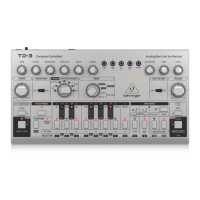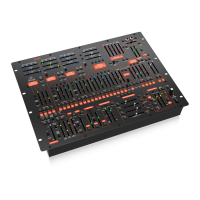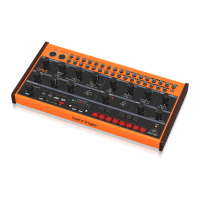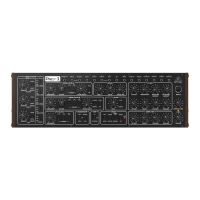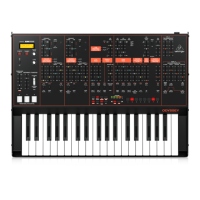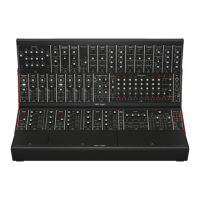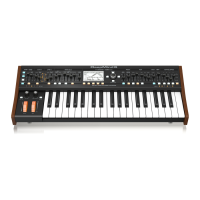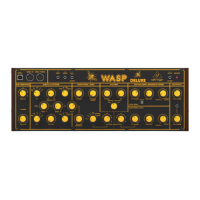11 NEUTRON User Manual
By default, the LFO is patched through the FILTER DEPTH control. This enables
modulation of the lter frequency using the LFO. The VCF has a second output
which is accessible from the patch bay (VCF 2). VCF 2 mode is determined by the
select VCF mode. The relationship is:
Mode = , VCF2 =
Mode = , VCF2 =
Mode = , VCF2 =
This allows for additional lter modes. For example, a notch lter can be created
when the lter mode is set to by summing VCF 1 and VCF 2, then patching the
summed output into OD IN.
KEY TRACK applies keyboard tracking to the VCF.
This sets the lter cuto frequency based on the latest MIDI note received. The
base cuto frequency is set using the FREQ control with MIDI notes increasing the
cuto frequency relative to the note being played. Additionally, this allows the
lter to be played like an oscillator when the resonance control is turned up.
4.6 LFO Section
The Neutron LFO has a frequency range of 0.01 Hz to 10 kHz. This allows low
frequency modulation up to audio rate modulation using the LFO.
The Shape control sets the type of LFO waveform. When selecting the LFO
waveform, the control can be set to select between xed types or to blend
between wave shapes. The ve LFO shapes are:
With KEY SYNC engaged, the LFO is re-triggered when a MIDI note is received.
Sine
Triangle
Sawtooth
Square
Reverse Sawtooth
(20)(18) (19)
4.7 Delay Section
The Neutron has an impressive analog bucket brigade delay section. Delay times
of 24 ms to 640 ms can be set. Eects from long dub delays to extreme chorusing
can be created. Set the MIX control at 12 o’clock. Then try turning the RATE
control fully left with the REPEAT control to the right a little for a long dub style
sound. Chorus eects can be created by modulating short delay times with an
LFO applied to the DELAY TIME input via one of the ATTENUATORS.
4.8 Overdrive Section
The overdrive section can be used to add subtle warmth through to extreme
distortion by using an analog soft clipping circuit. Turning the DRIVE control to
the right increases the amount of distortion, adding rich harmonics. The TONE
control shapes the sound of the overdrive. To the left, high-end ltering is applied
to take away the harsh edge. When the TONE control is turned to the right the
low end is ltered out to give a brighter sound. As DRIVE level is increased, the
LEVEL control can be utilized to turn down the volume of the synthesizer, without
aecting the drive or tone of the sound.
NOTE: If the level control is all the way down it is possible that no sound
will be heard.
4.9 Envelope Section
The Neutron contains two ADSR (Attack, Decay, Sustain, Release) envelopes. Both
envelopes are triggered when a MIDI note is received unless the E.GATE 1/2 inputs
are used.
ENVELOPE 1 is routed to the VCA CV by default. This allows the signal to pass
through the unit when a MIDI note is being played and closes the VCA when no
note is being played.
ENVELOPE 2 is routed to the VCF, via the ENV DEPTH control, by default. This can
be used to create lter sweeps when a MIDI note is being played. Try dierent
combinations of slow and fast settings to create dierent sounds and textures.
(24) (25)(23)
(26)
(27)
(28)
(36)(35)(34)(33)
(32)
(31)
(30)
(29)

